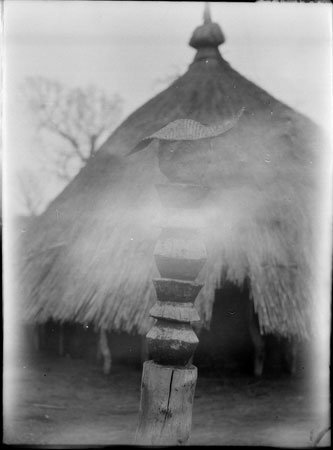Bongo grave carving

103 x 75 mm | Negative film nitrate
Date of Print:
Unknown
Previous PRM Number:
EP.B.26
Accession Number:
1998.343.26
Description:
A wooden carving set next to a grave incorporating a likeness of the deceased wearing a piece of matting as a hat, with notches carved below tallying two hippo killed by the individual.
This carving forms a group with five other posts set round a burial mound surmounted by three posts tallying twenty elephants killed.
Photographer:
Edward Evan Evans-Pritchard
Date of Photo:
1929 March
Region:
[Southern Sudan] Warab Tonj Koki
Group:
Karakiti Bongo
PRM Source:
Edward Evan Evans-Pritchard
Acquired:
Donated 1966
Other Owners:
E. E. Evans-Pritchard Collection
Class:
Death , Carving
Keyword:
Grave , Grave Marker , Memorial , Figure
Primary Documentation:
PRM Accession Records - Accession Book Entry [p.
98] 1966.27 [1 - 24] G[ift] PROFESSOR E.
E.
EVANS-PRITCHARD; INST.
OF SOCIAL ANTHROPOLOGY, 51 BANBURY RD.
OXFORD - 1966.27.19 - S.
SUDAN, DARFUNG.
VARIOUS TRIBES.
Box of negatives in envelopes, [1 - 242] & 1966.27.20 - Box of prints of these negatives [refers to object 1966.27.19] [1 - 242], in envelopes.
Other Information:
This grave mound is shown in Plate IVb (facing page 40) of E.
E.
Evans-Pritchard's article "The Bongo" (Sudan Notes and Records Vol.XII Part I 1929) with the caption 'Bongo grave surrounded by human figures and hunting tally-posts.
Note arrows sticking in posts.' [Chris Morton 13/1/2004] The Karakiti are identified as a Bongo sub-group living 'to the east of Tonj, in the neighbourhood of Koki to the south of Miniobolo'.
This group seem to be slightly detached from the main group on the Wau-Tonj road, living amidst Dinka groups.
("The Bongo" (Sudan Notes and Records Vol.XII Part I 1929, page 14).
[Chris Morton 13/1/2004] In "The Bongo" (Sudan Notes and Records Vol.XII Part I 1929, page 38) E.
E.
Evans-Pritchard notes that 'I was told that the posts were not carved to magnify the hunting deeds of the dead, and not to give just a general idea of his kills, but are an actuall tally, correct in numbers and in species.
Thus at one grave which I saw in the country of the Karatiki tribe there were three carved poles surmounting the heap of stones over the grave.
The carvings on these poles represented a tally of twenty elephants.
Round the grave, planted into the earth, were five other posts.
Walking round the grave clockwise the first post which one met was carved in the likeness of the dead, having bead eyes, and the face being stained blue with a dye bought from an Arab merchant, and the body being painted red with red ochre.
Next came a carved branching pole erected by the son-in-law of the dead man in honour of his wife's father, but upon which he recorded his own tally of buffaloes.
Then came another carved post in the likeness of the dead, but with carvings also which represented two hippopotami killed.
Next came a post (do masha) showing six carvings, each representing a rhinoceros.
Lastly, there was a post (do kobi) showing a bad of five buffaloes.' [Chris Morton 14/1/2004]
Recorder:
Christopher Morton 15/1/2004 [Southern Sudan Project]

